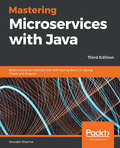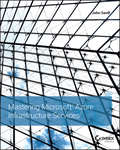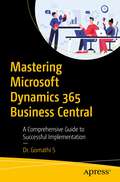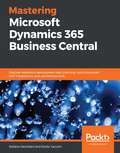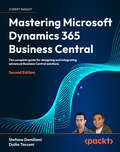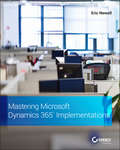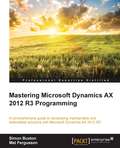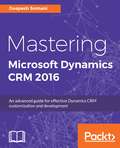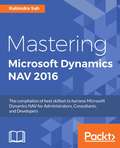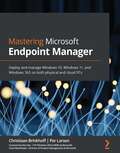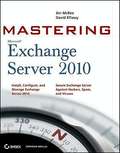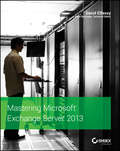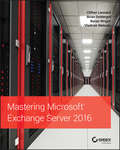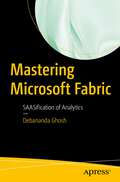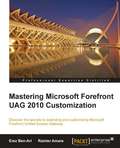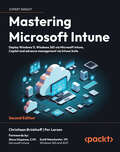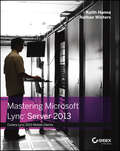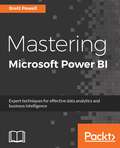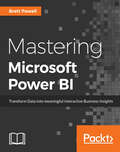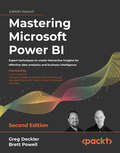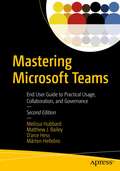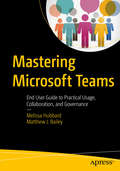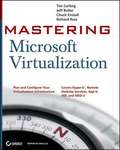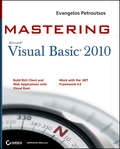- Table View
- List View
Mastering Microservices with Java: Build enterprise microservices with Spring Boot 2.0, Spring Cloud, and Angular, 3rd Edition
by Sourabh SharmaMaster the art of implementing scalable and reactive microservices in your production environment with Java 11Key FeaturesUse domain-driven designs to build microservicesExplore various microservices design patterns such as service discovery, registration, and API GatewayUse Kafka, Avro, and Spring Streams to implement event-based microservicesBook DescriptionMicroservices are key to designing scalable, easy-to-maintain applications. This latest edition of Mastering Microservices with Java, works on Java 11. It covers a wide range of exciting new developments in the world of microservices, including microservices patterns, interprocess communication with gRPC, and service orchestration.This book will help you understand how to implement microservice-based systems from scratch. You'll start off by understanding the core concepts and framework, before focusing on the high-level design of large software projects. You'll then use Spring Security to secure microservices and test them effectively using REST Java clients and other tools. You will also gain experience of using the Netflix OSS suite, comprising the API Gateway, service discovery and registration, and Circuit Breaker. Additionally, you'll be introduced to the best patterns, practices, and common principles of microservice design that will help you to understand how to troubleshoot and debug the issues faced during development.By the end of this book, you'll have learned how to build smaller, lighter, and faster services that can be implemented easily in a production environment.What you will learnUse domain-driven designs to develop and implement microservicesUnderstand how to implement microservices using Spring BootExplore service orchestration and distributed transactions using the SagasDiscover interprocess communication using REpresentational State Transfer (REST) and eventsGain knowledge of how to implement and design reactive microservicesDeploy and test various microservicesWho this book is forThis book is designed for Java developers who are familiar with microservices architecture and now want to effectively implement microservices at an enterprise level. Basic knowledge and understanding of core microservice elements and applications is necessary.
Mastering Microsoft Azure Infrastructure Services
by John SavillUnderstand, create, deploy, and maintain a public cloud using Microsoft Azure<P><P> Mastering Microsoft Azure Infrastructure Services guides you through the process of creating and managing a public cloud and virtual network using Microsoft Azure. With step-by-step instruction and clear explanation, this book equips you with the skills required to provide services both on-premises and off-premises through full virtualization, providing a deeper understanding of Azure's capabilities as an infrastructure service. <P> Each chapter includes online videos that visualize and enhance the concepts presented in the book, and access to a Windows app that provides instant Azure updates and demonstrates the process of going from on-premises to public cloud via Azure. Coverage includes storage customization, connectivity, virtual networks, backing up, hybrid environments, System Center management, and more, giving you everything you need to understand, evaluate, deploy, and maintain environments that utilize Microsoft Azure.<P> * Understand cost, options, and applications of Infrastructure as a Service (IaaS) <P> * Enable on- and off-premises connectivity to Azure<P> * Customize Azure templates and management processes <P> * Exploit key technologies and embrace the hybrid environment<P> Mastering Microsoft Azure Infrastructure Services is your total solution.
Mastering Microsoft Dynamics 365 Business Central: A Comprehensive Guide to Successful Implementation
by Dr. Gomathi SGet ready to ace Microsoft Dynamics 365 Business Central and usher in an era of streamlined efficiency, enhanced productivity, and growth. This guide book is your trusty companion on your journey to becoming an ERP implementation pro. The book will take you through the entire implementation process, from initial planning to successful deployment and beyond.The book starts with an introduction to Business Central and the benefits of its implementation. It discusses pre-implementation planning and vendor selection and partnership, and you will learn budgeting and timeline along with evaluating implementation partners. You will go through project management methodologies and learn about resource allocation and team roles. Data migration and cleansing are discussed, along with configuration and customization. You will learn about change management and user adoption, as well as Integration with existing systems. The book takes you through testing and quality assurance, and you will understand how to prepare for Go-Live. You also will learn common implementation challenges and solutions, and future trends in ERP and Business Central.After reading this book, you will be able to discover the full potential and make the most out of Microsoft Dynamics 365 Business Central.What Will You LearnMaster the complete process of Microsoft Dynamics 365 Business Central implementationImplement effective strategies to drive user adoption and overcome resistance to changeStay ahead of the curve by exploring emerging trends in the ERP landscapeUtilize practical tools and checklists to streamline implementation tasksGain insights from case studies for practical implementation strategiesWho This Book Is ForProject managers, business analysts, and ERP consultants
Mastering Microsoft Dynamics 365 Business Central: Discover extension development best practices, build advanced ERP integrations, and use DevOps tools
by Stefano Demiliani Duilio TacconiDevelop customized business management solutions with the latest features of Microsoft Dynamics 365 Business Central Key Features Learn Dynamics 365 Business Central, the next generation of Dynamics NAV Explore advanced topics for handling complex integrations such as using APIs, OData, and Azure Functions Discover best practices for developing SaaS extensions and moving existing solutions to the cloud Book Description Dynamics 365 Business Central is an all-in-one business management solution, which is easy to adopt and helps you make smarter business decisions. This book is a comprehensive guide to developing solutions with Microsoft ERP (in the cloud and also on-premises). It covers all aspects of developing extensions, right from preparing a sandbox environment to deploying a complete solution. The book starts by introducing you to the Dynamics 365 Business Central platform and the new Modern Development Environment. You'll then explore the sandbox concept, and see how to create sandboxes for development. As you advance, you'll be able to build a complete advanced solution for Dynamics 365 Business Central with AL language and Visual Studio Code. You'll then learn how to debug and deploy the extension and write automatic testing. The book will also take you through advanced topics like integration (with Azure Functions, web services, and APIs), DevOps and CI/CD techniques, and machine learning. You'll discover how Dynamics 365 Business Central can be used with Office 365 apps. Finally, you'll analyze different ways to move existing solutions to the new development model based on extensions. By the end of this book, you'll be able to develop highly customized solutions that meet the requirements of modern businesses using Dynamics 365 Business Central. What you will learn Create a sandbox environment with Dynamics 365 Business Central Handle source control management when developing solutions Explore extension testing, debugging, and deployment Create real-world business processes using Business Central and different Azure services Integrate Business Central with external applications Apply DevOps and CI/CD to development projects Move existing solutions to the new extension-based architecture Who this book is for If you're a new developer looking to get started with Dynamics 365 Business Central, this book is for you. This book will also help experienced professionals enhance their knowledge and understanding of Dynamics 365 Business Central.
Mastering Microsoft Dynamics 365 Business Central: The complete guide for designing and integrating advanced Business Central solutions
by Stefano Demiliani Duilio TacconiUtilize Microsoft Dynamics 365 Business Central's most recent capabilities to create bespoke business management solutions using best practices learned along the way from veterans in the industry. Purchase of the print or Kindle book includes a free PDF eBookKey FeaturesExtend Business Central's functionalities through Azure, Power Platform, GitHub, and custom extensionsUnlock the potential of data exchange and functionality expansion by integrating with external systems using APIs and ODataBuild reliable, maintainable, and continuously improving solutions while writing performant, well-structured code and using telemetries and DevOpsBook DescriptionThis book dives straight into guiding you through the process of building real-world solutions with the AL language and Visual Studio Code. It emphasizes best practices and extensibility patterns to ensure your extensions are well-structured, maintainable, and meet the needs of modern businesses. You'll learn advanced AL techniques, report creation methods, debugging strategies, and how to leverage telemetries for monitoring. Additionally, it covers performance optimization practices and API integration to help you create efficient and interconnected solutions. With a focus on extension development, this new edition allows you to jump right into coding without spending time on setup processes. This book introduces new chapters covering essential tasks that Business Central developers frequently encounter, such as file handling and printing management. Finally, the book expands its scope by including chapters on various integration aspects, including VS Code extensions, GitHub DevOps, Azure services, and Power Platform integrations. We’ll wrap up by covering Copilot capabilities in Business Central and how you can create your own generative AI copilots. By mastering these concepts and techniques, you'll be well-equipped to create powerful and customized solutions that extend the capabilities of Dynamics 365 Business Central.What you will learnDeveloping a customized solution for Dynamics 365 Business CentralWriting performant code following extensibility patternsHandling reporting, files, and printing on a cloud environmentHandling Business Central telemetries with AzureWriting APIs and integrations for Dynamics 365 Business CentralApplying DevOps and CI/CD to development projects by using GitHubIntegrating Business Central with Power PlatformPublishing your solutions to AppSource marketplaceManage Copilot capabilities and create your own generative AI copilotWho this book is forThis book is intended for new developers who want to get started with Dynamics 365 Business Central. Professionals with expertise will also benefit from this book by enhancing their knowledge and comprehension of Dynamics 365 Business Central development platform and best practices
Mastering Microsoft Dynamics 365 Implementations
by Eric NewellConfidently shepherd your organization’s implementation of Microsoft Dynamics 365 to a successful conclusion In Mastering Microsoft Dynamics 365 Implementations, accomplished executive, project manager, and author Eric Newell delivers a holistic, step-by-step reference to implementing Microsoft’s cloud-based ERP and CRM business applications. You’ll find the detailed and concrete instructions you need to take your implementation project all the way to the finish line, on-time, and on-budget. You’ll learn: The precise steps to take, in the correct order, to bring your Dynamics 365 implementation to life What to do before you begin the project, including identifying stakeholders and building your business case How to deal with a change management throughout the lifecycle of your project How to manage conference room pilots (CRPs) and what to expect during the sessions Perfect for CIOs, technology VPs, CFOs, Operations leaders, application directors, business analysts, ERP/CRM specialists, and project managers, Mastering Microsoft Dynamics 365 Implementations is an indispensable and practical reference for guiding your real-world Dynamics 365 implementation from planning to completion.
Mastering Microsoft Dynamics AX 2012 R3 Programming
by Simon Buxton Mat FergussonIf you are a software developer new to Dynamics AX programming or an experienced developer migrating from an earlier version of Dynamics AX, this book is an ideal tutorial to help you avoid the common pitfalls and make the most of this advanced technology. This book is also useful if you are a solution architect or technical consultant, as it provides a deeper insight into the technology behind the solution.
Mastering Microsoft Dynamics CRM 2016
by Deepesh SomaniThis comprehensive guide covers all the essential features of Dynamics CRM so you can build effective applications. About This Book • Harness the full power of Dynamics CRM 2016 through real-world scenarios • Create efficient client-side applications and customized plugins that work seamlessly across mobile and the Web • Get to know the best practices from field experience to utilize Dynamics CRM 2016 efficiently • Get an in-depth understanding of mobility and tablet options for Dynamics CRM 2016 Who This Book Is For This book is for those with Dynamics CRM knowledge who want to utilize the latest features available with Dynamics CRM 2016 and Update 1. Extensive Dynamics CRM development experience would be beneficial. What You Will Learn • Learn to manage the sales, service, and marketing divisions of any organization using entities and other Dynamics CRM 2016 customizations • Learn about the XRM framework of Dynamics CRM 2016 and leverage its features • Provide an enhanced mobile and tablet experience using the latest features of Dynamics CRM • Get an enhanced Dynamics CRM analytics experience with Word and Excel templates • Develop client-side applications using JavaScript and Web API • How to develop plugins and workflows using Dynamics CRM 2016 • Solution framework improvements, new field types, and Relevant Search in Dynamics CRM 2016 In Detail Microsoft Dynamics CRM is the most trusted name in enterprise-level customer relationship management. The latest version of Dynamics CRM 2016 comes with some exciting extra features guaranteed to make your life easier with Dynamics CRM. This book provides a comprehensive coverage of Dynamics CRM 2016 and helps you make your tasks much simpler while elevating you to the level of an expert. The book starts with a brief overview of the functional features and then introduces the latest features of Dynamics CRM 2016. You will learn to create Word and Excel templates, using CRM data that will enable you to provide customized data analysis for your organization. You will understand how to utilize Dynamics CRM as an XRM Framework, gain a deep understanding about client-side scripting in Dynamics CRM, and learn creating client-side applications using JavaScript and Web API. We then introduce visual control frameworks for Dynamics CRM 2016 mobile and tablet applications. Business Process Flows, Business Rules, and their enhancements are introduced. By the end of this book, you will have mastered utilizing Dynamics CRM 2016 features through real-world scenarios. Style and approach This book takes a practical, step-by-step approach, providing real-world case studies that enable readers to leverage the latest and most advanced features of Dynamics CRM.
Mastering Microsoft Dynamics NAV 2016
by Rabindra SahThe compilation of best skillset to harness Microsoft Dynamics NAV for Administrators, Consultants, and Developers About This Book • Take your skills to the next level with Dynamics NAV by implementing all the latest and advanced features • Get a comprehensive coverage of how the NAV system can be implemented and maintained to get the most out of it • Get powerful insights into how to integrate Dynamics NAV with third-party tolls and extend its functionality Who This Book Is For This book is ideal for administrators, developers, and consultants who are looking to take their knowledge of Dynamics NAV to new heights. You're expected to have a basic knowledge of Dynamics NAV workflows and C/AL, C/SIDE development. What You Will Learn • Installing the NAV system in different environments • Implementing the system with the correct setup • Maintaining the system to get the best possible performance • Tuning up the Dynamics NAV to get better outcomes • The Version Control strategy for Dynamics NAV developers • Integrating other software and features to remove limitations • Understanding your own system better • Being able to solve customers' problems with “out-of-the-box” features • Reducing customization and additional development time In Detail The book begins by giving you a brief introduction to setting up your NAV environment and shows you how to install and configure it according to your requirements. You will then dive deep into the latest design patterns, network architecture, and topologies. We will show you how you can integrate NAV with the Microsoft platform, and secure your deployment by managing roles and permissions. Moving on, we will explain how to monitor and manage server instances using the Administration tool. We'll discuss how you can take advantage of the expanded extensibility and connectivity capabilities for a tighter integration with the cloud as well as handheld devices. Then, we'll show you how you can make use of the PowerBI capabilities that have been built into Dynamics NAV. By the end of the book, you will be confident in developing and administering a Dynamics NAV implementation that will leverage all of the new features. Style and approach This book takes a straightforward tutorial approach, providing you with step-by-step explanations and simple example-oriented walkthroughs. It is filled with use cases and situations that show you the different pitfalls you might encounter and how to get past them.
Mastering Microsoft Endpoint Manager: Deploy and manage Windows 10, Windows 11, and Windows 365 on both physical and cloud PCs
by Christiaan Brinkhoff Per Larsen Ken Pan Scott ManchesterDesign and implement a secure end-to-end desktop management solution with Microsoft Endpoint ManagerKey FeaturesLearn everything you need to know about deploying and managing Windows on physical and cloud PCsSimplify remote working for cloud-managed cloud PCs via new service Windows 365Benefit from the authors' experience of managing physical endpoints and traditional virtual desktop infrastructures (VDI)Book DescriptionOne of the main reasons for the slow adoption of Modern Workplace solutions designed to simplify the management layer of your environment is the lack of understanding and knowledge of the product. With this book, you'll learn everything you need to know to make the shift to Modern Workplace, running Windows 10, Windows 11, or Windows 365. Mastering Microsoft Endpoint Manager explains various concepts in detail to give you the clarity to plan how to use Microsoft Endpoint Manager (MEM) and eliminate potential migration challenges beforehand. You'll get to grips with using new services such as Windows 365 Cloud PC, Windows Autopilot, profile management, monitoring and analytics, and Universal Print. The book will take you through the latest features and new Microsoft cloud services to help you to get to grips with the fundamentals of MEM and understand which services you can manage. Whether you are talking about physical or cloud endpoints—it's all covered. By the end of the book, you'll be able to set up MEM and use it to run Windows 10, Windows 11, and Windows 365 efficiently.What you will learnUnderstand how Windows 365 Cloud PC makes the deployment of Windows in the cloud easyConfigure advanced policy management within MEMDiscover modern profile management and migration options for physical and cloud PCsHarden security with baseline settings and other security best practicesFind troubleshooting tips and tricks for MEM, Windows 365 Cloud PC, and moreDiscover deployment best practices for physical and cloud-managed endpointsKeep up with the Microsoft community and discover a list of MVPs to followWho this book is forIf you are an IT professional, enterprise mobility administrator, architect, or consultant looking to learn about managing Windows on both physical and cloud endpoints using Microsoft Endpoint Manager, this book is for you.
Mastering Microsoft Exchange Server 2010
by Jim Mcbee David ElfassyA top-selling guide to Exchange Server-now fully updated for Exchange Server 2010. Keep your Microsoft messaging system up to date and protected with the very newest version, Exchange Server 2010, and this comprehensive guide. Whether you're upgrading from Exchange Server 2007 SP1 or earlier, installing for the first time, or migrating from another system, this step-by-step guide provides the hands-on instruction, practical application, and real-world advice you need. Explains Microsoft Exchange Server 2010, the latest release of Microsoft's messaging system that protects against spam and viruses and allows for access to e-mail, voicemail, and calendars from a variety devices and any location Helps you thoroughly master the new version with step-by-step instruction on how to install, configure, and manage this multifaceted collaboration system Covers planning and design, installation, administration and management, maintenance and more Install or update your Microsoft Exchange Server with this guide, then keep it on hand for a comprehensive reference. Note: CD-ROM/DVD and other supplementary materials are not included as part of eBook file.
Mastering Microsoft Exchange Server 2013
by David ElfassyThe bestselling guide to Exchange Server, fully updated for the newest version Microsoft Exchange Server 2013 is touted as a solution for lowering the total cost of ownership, whether deployed on-premises or in the cloud. Like the earlier editions, this comprehensive guide covers every aspect of installing, configuring, and managing this multifaceted collaboration system. It offers Windows systems administrators and consultants a complete tutorial and reference, ideal for anyone installing Exchange Server for the first time or those migrating from an earlier Exchange Server version.Microsoft Exchange Server 2013 is a messaging system that allows for access to e-mail, voicemail, and calendars from a variety of devices and any location, making it ideal for the enterpriseWith more than 21,000 copies of earlier editions sold, this comprehensive guide offers systems administrators and consultants both a tutorial and a reference guide for installing and managing Exchange Server 2013A team of Microsoft Certified Masters walks you step by step through planning and design, installation, administration and management, maintenance, and moreMastering Microsoft Exchange Server 2013 is the complete reference for planning, installing, and maintaining the most popular e-mail server product available.
Mastering Microsoft Exchange Server 2016
by Byron Wright Brian Svidergol Clifton Leonard Vladimir MeloskiA bestselling Exchange Server guide, updated for the 2016 release Mastering Microsoft Exchange Server 2016 is the gold-standard reference for system administrators and first-time users alike. Fully updated to align with the latest release, this expert-led guide provides comprehensive coverage and easy-to-follow tutorials for all aspects of Exchange Server installation, configuration, and management. Whether you're migrating from an earlier version or installing Exchange Server for the first time, this book gives you quick access to the answers you need. Step-by-step instructions walk you through planning and design, installation, administration and management, maintenance, and more, so you can get up to speed quickly and get back to work. With a focus on the hands-on details, the Microsoft Certified Masters author team provides practical insight and invaluable guidance on every aspect of Exchange Server 2016, from mastering the basics to leveraging new features. Microsoft Exchange allows access to e-mail, voicemail, and calendars at any time, from almost any device. The 2016 release is designed specifically to appeal to enterprises; if you've been tasked with the implementation, this guide has the information you need. Get up to speed with the latest changes and features Understand server configurations, requirements, installation, and migration Manage mailboxes, groups, connectivity, and the client access server Troubleshoot common issues efficiently and effectively Exchange Server 2016 shifts even more control to the user, freeing administrators to perform more critical tasks. Beefed-up architecture and more centralized functions have eased configuration and upgrades, and a robust cloud implementation is expected to draw enterprises sooner rather than later. Systems administrators need to become familiar with the latest changes, and Mastering Microsoft Exchange Server 2016 is the ultimate reference and tutorial.
Mastering Microsoft Fabric: SAASification of Analytics
by Debananda GhoshLearn and explore the capabilities of Microsoft Fabric, the latest evolution in cloud analytics suites. This book will help you understand how users can leverage Microsoft Office equivalent experience for performing data management and advanced analytics activity. The book starts with an overview of the analytics evolution from on premises to cloud infrastructure as a service (IaaS), platform as a service (PaaS), and now software as a service (SaaS version) and provides an introduction to Microsoft Fabric. You will learn how to provision Microsoft Fabric in your tenant along with the key capabilities of SaaS analytics products and the advantage of using Fabric in the enterprise analytics platform. OneLake and Lakehouse for data engineering is discussed as well as OneLake for data science. Author Ghosh teaches you about data warehouse offerings inside Microsoft Fabric and the new data integration experience which brings Azure Data Factory and Power Query Editor of Power BI together in a single platform. Also demonstrated is Real-Time Analytics in Fabric, including capabilities such as Kusto query and database. You will understand how the new event stream feature integrates with OneLake and other computations. You also will know how to configure the real-time alert capability in a zero code manner and go through the Power BI experience in the Fabric workspace. Fabric pricing and its licensing is also covered.After reading this book, you will understand the capabilities of Microsoft Fabric and its Integration with current and upcoming Azure OpenAI capabilities.What You Will LearnBuild OneLake for all data like OneDrive for Microsoft OfficeLeverage shortcuts for cross-cloud data virtualization in Azure and AWSUnderstand upcoming OpenAI integrationDiscover new event streaming and Kusto query inside Fabric real-time analyticsUtilize seamless tooling for machine learning and data scienceWho This Book Is ForCitizen users and experts in the data engineering and data science fields, along with chief AI officers
Mastering Microsoft Forefront UAG 2010 Customization
by Erez Ben-Ari Rainier Amara"Mastering Microsoft Forefront UAG 2010 Customization" is a hands-on guide with step-by-step instructions for enhancing the functionality of UAG through customization. Each topic details one key aspect of functionality and the operative mechanism behind it, and suggests functionality that can be achieved with customization, along with helpful code samples. Whether you are a seasoned UAG consultant, deployment and support engineer or a UAG customer, this book is for you. Consultants will be able to enhance the services you can provide for UAG customization, while the book helps customers to achieve tasks that have been restricted to the realm of expert consultants until now. You should have a strofng understanding of the regular functionality of UAG, as well as a solid background in web development (ASP, HTML, CSS and JavaScript) for this book to take you to the next level.
Mastering Microsoft Intune: Deploy Windows 11, Windows 365 via Microsoft Intune, Copilot and advance management via Intune Suite
by Christiaan Brinkhoff Per LarsenGet ready to master Microsoft Intune and revolutionize your endpoint management strategy with this comprehensive guide and provide next-level security with the Intune Suite. Includes forewords from Scott Manchester, Vice President, Windows 365 + AVD and Steve Dispensa Corporate Vice President, Microsoft Intune.Key FeaturesThis new edition covers the latest updates of Microsoft Intune, Windows 365, Intune Suite, Windows Autopatch, Microsoft Defender and Universal PrintGet detailed guidance on device enrolment, app deployment, management, data security, and policy configurationSecure data on personal devices with app policies, encryption, and moreBook DescriptionThe slow adoption of modern Work solutions, which are designed to streamline the management of your environment, can often be attributed to a lack of understanding and familiarity with those solutions. This book will provide you with all the information you need to successfully transition to Microsoft Intune. Mastering Microsoft Intune, Second Edition, explains various concepts in detail to give you the clarity on how to use Microsoft Intune and eliminate any migration challenges. You'll master Cloud Computing services such as Windows 365 Cloud PCs, Intune Suite, Windows Autopatch, Windows Autopilot, profile management, monitoring and analytics, Universal Print, and much more. The book will take you through the latest features and new Microsoft Cloud services to help you to get grips with the fundamentals of Intune and understand which services you can manage. Whether you're interested in physical or cloud endpoints it's all covered. By the end of the book, you'll be able to set up Intune and use it to run Windows and Windows 365 efficiently, using all the latest features of Intune.What you will learnSimplify the deployment of Windows in the cloud with Windows 365 Cloud PCsDeliver next-generation security features with Intune SuiteSimplify Windows Updates with Windows AutopatchConfigure advanced policy management within IntuneDiscover modern profile management and migration options for physical and Cloud PCsHarden security with baseline settings and other security best practicesFind troubleshooting tips and tricks for Intune, Windows 365 Cloud PCs, and moreDiscover deployment best practices for physical and cloud-managed endpointsWho this book is forIf you're an IT professional, enterprise mobility administrator, architect, or consultant looking to learn about managing Windows on both physical and cloud endpoints using Microsoft Intune, then this book is for you.
Mastering Microsoft Lync Server 2013
by Nathan Winters Keith HannaEverything you need to know to get Lync 2013 up and running smoothly As a Unified Communications (UC) technology, Lync allows you to keep track of your contacts' availability so you can communicate with anyone, anywhere, and at any time. With this hands-on book, you will learn how to administer the newest and most robust version of Lync Server in order to send an IM; start or join an audio, video, or web conference; or make a phone call through a familiar interface. Packed with real-world exercises throughout, this unique resource encourages you to learn from the best practices and deployments of others so that you can benefit from their experiences. Walks you through designing and managing enterprise instant messaging and conferencing solutionsDetails how to configure voicemail, enterprise voice, dual-forking, and VoIPTeaches you how to automate management tasksShares invaluable advice for monitoring, diagnosing, and troubleshooting problems Helps you understand SIP and authentication technologiesWith Mastering Microsoft Lync Server 2013, you'll gain the skills you need to effectively deploy Lync Server 2013 and be on your way to gaining all the benefits UC has to offer.
Mastering Microsoft Power BI: Expert Techniques For Effective Data Analytics And Business Intelligence
by Brett PowellThis book will show you how to use Power BI effectively to create a variety of visualizations and BI dashboards. Right from gathering data through various data sources, you will learn to perform effective visual analytics. By the end of this book, you will be able to gain unique, hidden insights into your data using Microsoft Power BI.
Mastering Microsoft Power BI: Expert techniques for effective data analytics and business intelligence
by Brett PowellDesign, create and manage robust Power BI solutions to gain meaningful business insightsKey FeaturesMaster all the dashboarding and reporting features of Microsoft Power BICombine data from multiple sources, create stunning visualizations and publish your reports across multiple platformsA comprehensive guide with real-world use cases and examples demonstrating how you can get the best out of Microsoft Power BIBook DescriptionThis book is intended for business intelligence professionals responsible for the design and development of Power BI content as well as managers, architects and administrators who oversee Power BI projects and deployments. The chapters flow from the planning of a Power BI project through the development and distribution of content to the administration of Power BI for an organization. BI developers will learn how to create sustainable and impactful Power BI datasets, reports, and dashboards. This includes connecting to data sources, shaping and enhancing source data, and developing an analytical data model. Additionally, top report and dashboard design practices are described using features such as Bookmarks and the Power KPI visual. BI managers will learn how Power BI's tools work together such as with the On-premises data gateway and how content can be staged and securely distributed via Apps. Additionally, both the Power BI Report Server and Power BI Premium are reviewed. By the end of this book, you will be confident in creating effective charts, tables, reports or dashboards for any kind of data using the tools and techniques in Microsoft Power BI.What you will learnBuild efficient data retrieval and transformation processes with the Power Query M LanguageDesign scalable, user-friendly DirectQuery and Import Data ModelsDevelop visually rich, immersive, and interactive reports and dashboardsMaintain version control and stage deployments across development, test, and production environmentsManage and monitor the Power BI Service and the On-premises data gatewayDevelop a fully on-premise solution with the Power BI Report ServerScale up a Power BI solution via Power BI Premium capacity and migration to Azure Analysis Services or SQL Server Analysis ServicesWho this book is forBusiness Intelligence professionals and existing Power BI users looking to master Power BI for all their data visualization and dashboarding needs will find this book to be useful. While understanding of the basic BI concepts is required, some exposure to Microsoft Power BI will be helpful.
Mastering Microsoft Power BI: Expert techniques to create interactive insights for effective data analytics and business intelligence, 2nd Edition
by Brett Powell Greg DecklerPlan, design, develop, and manage robust Power BI solutions to generate meaningful insights and make data-driven decisionsKey FeaturesMaster the latest dashboarding and reporting features of Microsoft Power BICombine data from multiple sources, create stunning visualizations and publish Power BI apps to thousands of usersGet the most out of Microsoft Power BI with real-world use cases and examplesBook DescriptionMastering Microsoft Power BI, Second Edition, provides an advanced understanding of Power BI to get the most out of your data and maximize business intelligence. This updated edition walks through each essential phase and component of Power BI, and explores the latest, most impactful Power BI features. Using best practices and working code examples, you will connect to data sources, shape and enhance source data, and develop analytical data models. You will also learn how to apply custom visuals, implement new DAX commands and paginated SSRS-style reports, manage application workspaces and metadata, and understand how content can be staged and securely distributed via Power BI apps. Furthermore, you will explore top report and interactive dashboard design practices using features such as bookmarks and the Power KPI visual, alongside the latest capabilities of Power BI mobile applications and self-service BI techniques. Additionally, important management and administration topics are covered, including application lifecycle management via Power BI pipelines, the on-premises data gateway, and Power BI Premium capacity. By the end of this Power BI book, you will be confident in creating sustainable and impactful charts, tables, reports, and dashboards with any kind of data using Microsoft Power BI.What you will learnBuild efficient data retrieval and transformation processes with the Power Query M language and dataflowsDesign scalable, user-friendly DirectQuery, import, and composite data modelsCreate basic and advanced DAX measuresAdd ArcGIS Maps to create interesting data storiesBuild pixel-perfect paginated reportsDiscover the capabilities of Power BI mobile applicationsManage and monitor a Power BI environment as a Power BI administratorScale up a Power BI solution for an enterprise via Power BI Premium capacityWho this book is forBusiness Intelligence professionals and intermediate Power BI users looking to master Power BI for all their data visualization and dashboarding needs will find this book useful. An understanding of basic BI concepts is required and some familiarity with Microsoft Power BI will be helpful to make the most out of this book.
Mastering Microsoft Teams: Creating a Hub for Successful Teamwork in Office 365
by Christina Wheeler Johnny LopezGet the most out of Microsoft Teams with this comprehensive and insightful resource Mastering Microsoft Teams: Creating a Hub for Successful Teamwork in Office 365 shows readers how to communicate intelligently and effectively within Microsoft&’s powerful Office 365. This book covers all the topics required for a full and comprehensive understanding of collaborating within the Microsoft suite of software, including: Architecture Implementing Teams Teams and Channels Chats, Calls and Meetings Extending Teams with Custom Apps Conferencing Security and Compliance Best Practices for Organizational Success Written for IT administrators, managers, supervisors, and team members who participate or want to participate in a Microsoft Teams environment, Mastering Microsoft Teams introduces readers to the architecture and structure of the software before showing, in a straightforward and simple way, how to optimize the collaboration experience.
Mastering Microsoft Teams: End User Guide to Practical Usage, Collaboration, and Governance
by Melissa Hubbard Matthew J. Bailey Mårten Hellebro D'arce HessDo you need to learn how to use Microsoft Teams? Are you questioning how to drive user adoption, govern content, and manage access for your Teams deployment? Either way, the second edition of this bestseller is your one-stop-shop to learning everything you need to know to find success with Microsoft Teams. Microsoft’s popular chat-based collaboration software has many rich features that enable teams to be more efficient, and save valuable time and resources. However, as with all software, there is a learning curve and pitfalls that should be avoided. Begin by learning the core components and use cases for Teams. From there, the authors guide you through ideas to create governance and adoption plans that make sense for your organization or customer. Wrap up with an understanding of features and services in progress, and a roadmap to the future of the product. What You Will Learn Implement, use, and manage Microsoft TeamsUnderstand how Teams drives productivity and engagement by combining the functionality of Microsoft 365 Groups, SharePoint, OneDrive, Outlook, and other services in one locationGovern, explain, and use Teams in your organizationUse Teams in a structured way to reduce users’ time spent in meetingsKnow the pitfalls to avoid that may create challenges in your usage of TeamsBecome familiar with the functionality and components of Teams via walk-throughs, including opportunities for automating business processes in TeamsSee how educators and students can use Teams to improve remote learningBe aware of business productivity in a remote world with Microsoft Viva Who This Book Is ForAnyone who wants to learn Microsoft Teams. To get the most out of the book, a basic understanding of Microsoft 365 and a subscription, including a Microsoft Teams license, is useful.
Mastering Microsoft Teams: End User Guide to Practical Usage, Collaboration, and Governance
by Melissa Hubbard Matthew J. BaileyDo you need to learn how to use Microsoft Teams? Are you questioning how to drive user adoption, govern content, and manage access for your Teams deployment? Either way, Mastering Microsoft Teams is your one-stop-shop to learning everything you need to know to find success with Microsoft Teams. Microsoft’s new chat-based collaboration software has many rich features that enable teams to be more efficient, and save valuable time and resources. However, as with all software, there is a learning curve and pitfalls that should be avoided. Begin by learning the core components and use cases for Teams. From there the authors guide you through ideas to create governance and adoption plans that make sense for your organization or customer. Wrap up with an understanding of features and services in progress, and a road map to the future of the product. What You'll Learn Implement, use, and manage Microsoft TeamsUnderstand how Teams drives productivity and engagement by combining the functionality of Microsoft Groups, SharePoint, OneDrive, Outlook, and other services in one locationGovern, explain, and use Teams in your organizationKnow the pitfalls to avoid that may create challenges in your usage of TeamsBecome familiar with the functionality and components of Teams via walkthroughs, including opportunities for automating business processes in Teams Who This Book Is ForAnyone who wants to learn Microsoft Teams. To get the most out of the book, a basic understanding of Office 365 and a subscription, including a Microsoft Teams license, is useful.
Mastering Microsoft Virtualization
by Jeffrey L. Buller Tim CerlingThe first in-depth, comprehensive guide to Microsoft's suite of virtualization productsVirtualization is a hot topic for IT because of the potential it offers for serious economic benefits. While other books treat server virtualization alone, this comprehensive guide provides a complete virtual strategy.You will learn how to deploy a complete virtualization stack with Microsoft's offerings in server virtualization, application virtualization, presentation virtualization, and desktop virtualization. Written by Microsoft technology product specialists, this guide provides real-world focus, enabling you to create a complete IT system that is highly efficient and cost effective.Covers Windows Server 2008 Hyper-V 2.0, Remote Desktop Services, Microsoft Application Virtualization (App-V), Virtual Desktop Infrastructure (VDI), and Microsoft Enterprise Desktop Virtualization (MED-V)Demonstrates how to deploy a virtual infrastructure-from the server to the desktopGoes beyond any other book on Microsoft virtualizationCovers the highly anticipated new feature Live MigrationThis guide, part of the popular Sybex Mastering series, offers every IT administrator a road map for implementing an efficient and successful virtualization project.
Mastering Microsoft Visual Basic 2010
by Evangelos PetroutsosThe new edition of the ultimate comprehensive guide to Microsoft Visual Basic Where most VB books start with beginner level topics, Mastering Visual Basic 2010 vaults you right into intermediate and advanced coverage. From the core of the language and user interface design to developing data-driven applications, this detailed book brings you thoroughly up to speed and features numerous example programs you can use to start building your own apps right away. Covers Visual Basic 2010, part of Microsoft's Visual Studio integrated development environment (IDE), which includes C#, C++, Visual Web Developer, and ASP.NET, along with Visual Basic Explains topics in the thorough, step-by-step style of all books in the Mastering series, providing you ample instruction, tips, and techniques Helps you build your own applications by supplying sample code you can use to start development Includes review exercises in each chapter to reinforce concepts as you learn All the books in the Sybex Mastering series feature comprehensive and expert coverage of topics you can put to immediate use. Note: CD-ROM/DVD and other supplementary materials are not included as part of eBook file.
